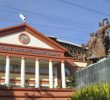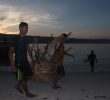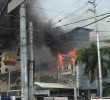DAVAO CITY — The environmental group Interface Development Interventions (Idis) has warned that the water crisis now being experienced in Metro Manila and many parts of Luzon can also happen to Davao.
The Davao region, particularly the city, is said to have one of the best water resources in the world. But that, according to Lia Jasmin Esquillo, executive director of Idis, is not an assurance that the city will be spared from the water crisis that has struck Metro Manila and Luzon. Esquillo said the city’s landscape has underwent rapid and major alterations in recent years, affecting its aquifers.
Although blessed with abundant and clean water, Davao’s residents should be prepared for the possibility that their city will suffer from inadequate supply, knowing how the watersheds of the city are slowly being encroached into by plantations that use environmentally hazardous chemicals, Esquillo said.
�Over the years, we have warned about the wanton destruction of Davao�s upland watersheds and their surrounding environment by banana and pineapple plantations,” Esquillo said. “We have already sounded the alarm that converting these areas to these plantations spells disaster which we might come sooner than later.�
In Davao�s third district alone, banana plantations are estimated to have reached over 5,000 hectares while pineapple plantations so far have occupied more than 1,000 hectares. Most of these plantations are on top of recharge zones, which are areas of land through which water passes through holes or cracks in soil and rock to fill an aquifer. Deep-rooted trees should be planted in recharge zones so that the rainwater can refill the aquifers, Esquillo said.
The city is currently sourcing its supply of potable water from the Talomo-Lipadas watershed located within the third district, the same district where thousands of banana and pineapple plantations can be found. Bananas and pineapples have very shallow root systems.
The Davao City Water District (DCWD) identified the Panigan-Tamugan watershed, also in the third district, as the future source of drinking water for Davao. However, even this watershed is being threatened by the expansion of chemically dependent mono-culture farming, such as bananas.
�The picture of environmental destruction — the destruction of the upland watershed areas of Davao — is so alarming and it�s sad that not too many people in the city care to take a look at it and actually do something to arrest it,” Esquillo said.
�It is sad that people do not really give too much importance to this and what is more disheartening is that, in the face of this apathy is a government that prioritizes agricultural projects and programs that are oppressive and destructive,� Esquillo said.
Recently, the Department of Environment and Natural Resources (DENR) said that the country will be facing a shortage in the supply of freshwater in the year 2010, or three years from now.
In its report, the DENR identified Davao as among the many major cities in the country that are currently suffering from a shortage in freshwater supply.
A study made by the Asian Development Bank (ADB) shows that at least 431 municipalities outside Metro Manila are waterless now. Locally, a critical number of communities in the second district are perennially suffering low supply of water.
�If we all allow the continuous expansion of these plantations, we can only expect to suffer the worse in the future and we don�t even have to wait for 2010 to see and experience this. In fact, right now, many communities in the city do not have access to fresh water,� Esquillo said.










